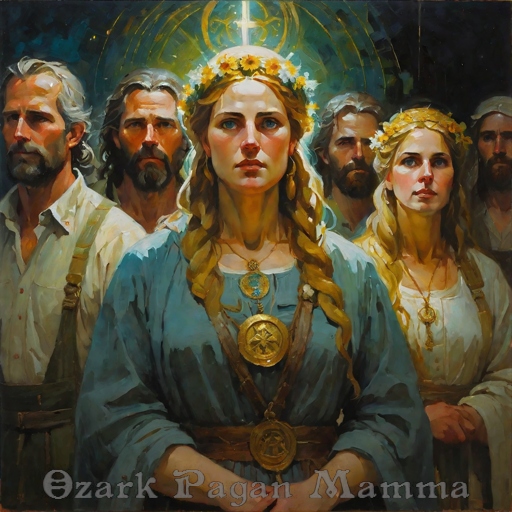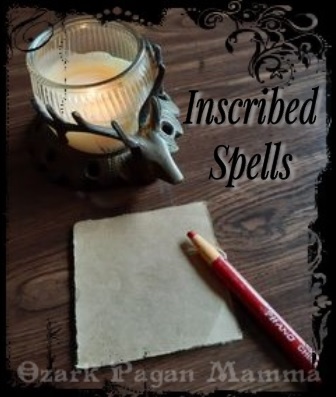Though these terms are often used interchangeably…
Talismans are objects meant to actively attract favorable influences and bring good fortune, and are usually made to a specific purpose. They are for empowering or amplifying magic.
An amulet is generally a passive protective object that wards off bad luck, and is a general shield against evil. They are for protective or defensive magic.
Charm is a word that often describes both of these, but is more often meant for luck. A charm can be a pendant or other object on which you’ve etched magical symbols. It can also be a natural object (or objects) you keep them in your pocket, shoe, or tied or pinned to the clothing.
Sometimes you will find the word charm used to mean a spoken spell. This is the older use of the word– any act of speaking power into being, by manner or singing, chanting, whispering, or intoning. I wonder if a physical charm was originally named that because a charm was spoken over it? Perhaps it’s just that the object called a charm stands as a symbol or substitute for the spoken word?
In any case, here are some frequently used physical charms used in Ozark folk magic…
Iron – Legend has it that iron repels haints and evil spirits of all kinds. A common explanation for the origins of this belief is that it comes from the time when bronze age people first encountered tribes equipped with iron weapons. The process of making iron was regarded as magical as was blacksmiths themselves. Pieces of iron were sewn into, or iron pins or brooches were stuck into; clothes, to avert evil. Women in labor were protected by a row of iron nails or a reaping hook. Iron weapons and horseshoes were regarded as especially protective. A piece of iron can be rubbed on skin and objects to stroke away pain or illness.
Copper – Copper bracelets are worn for arthritis and protection against many kinds of illness.
Silver – According to legend, silver is a holy metal which can injure evil. Silver is related to the moon and brings protection, wealth, and the blessing. In Ozark tradition, one is to touch a silver coin, or coin jewelry, while looking at the moon, as a charm for prosperity. (Dimes minted before 1965 contain 90% silver.)
Coins – Wearing or carrying a silver dime is said to give you a warning that you’ve stepped over a hex laid out for you, as it will turn black if you did. Bent coins are carried for good luck, as are pennies found heads-up. Holed pennies can be worn for different purposes: one with the hole through President Lincoln’s head treats a headache, a hole through the heart soothes matters of love, a hole in front of him is for luck, and one behind him protects from hexes. The hole cannot be made by the bearer in their own home, but elsewhere by someone else, with a hammer and nail.
Holey Stones – These are also called hagstones or peep stones. They are stones with natural holes in them. They’re carried for good luck, protection from the Little Folk, and clusters of them are strung up with wire on bed posts for nightmare prevention.
Horseshoes – The use of old horseshoes as magically protective amulets, especially hung above doorways, originated in Europe, where they are still nailed to houses, barns, and stables from Italy through Germany and up into Britain and Scandinavia. Additionally, wall hangings, jewelry, and printed images made in the form of horseshoes are common. It is also the most commonly encountered lucky charm in North America. Americans of English and Irish descent prefer to display horseshoes with the point facing up, to hold in the luck. Although actual horseshoes still serve a magically protective function when nailed above a door, modern horseshoe jewelry is worn not for protection, but for its lucky power.
Clover – A four-leafed clover is felt to be especially lucky. Clover is a symbol of life, luck and abundance.
Salt – Salt, though alone may not constitute a charm, is often used as an ingredient in composite charms and other magics. It is considered to be a hallowing substance that purifies, repels evil, and attracts wealth. (If using outdoors, I would recommend using epsom salt instead, which is better for the environment.)
Buttons – A button received as a gift is always lucky, no matter what the color. (Collecting and exchanging buttons and putting them on charm necklaces used to be a thing, a long time ago.) However, best not pick up any black buttons you find saying around somewhere. These are lost on purpose by people who want to get rid of some bad luck.
Feathers – Black feathers are used for Ozark sweeping magic (but more about that later). They’re also worn or carried to ward off rheumatism. In the Appalachians, buzzard feathers are hung above a doorway to prevent illness. Dove feathers in a pillow prevent nightmares, and duck feathers bring good luck in money. (However, I have to mention that it is illegal in the U.S. to have any part of a migratory bird, no matter how you came into possession of it, even if the feathers were simply found in nature no harm to a bird was done.)
Parts of Trees – There are quite a few charms that are components of trees. I’ve covered some of these in my article Ozark Tree Magic & Spirituality. Buckeyes are a widespread good luck charm that was once very popular in the Ozarks and are carried in a pocket and rubbed for good luck. Lightning-struck wood is considered lucky (as long as you don’t burn it in the home). Cedar chips are carried in pockets to ward off evil spirits and disease.
There are quite a few Ozark charms concerning love and relationships- I wrote about them a few years back in a post titled Ozark Love Charms & Magic.
I’m sure there are many physical charms I’ve left out, but these are some of the better known ones. Now let’s talk about the other meaning of the word charm…
Spoken Charms
An easy and traditional way to “charm” an object is to say a prayer over it and name its magical purpose. In fact, most of the traditional Ozark magical practitioners (yarb doctors, two-headed doctors, and the like) would have used Christian prayers and bible verses almost exclusively.
Since I am not a Christian practitioner, I use other sources (including my own imagination) for inspiration. My favorite, that I use in both devotional practices and in magic, is the Tree of Life prayer I mentioned in an earlier post.
I like to time some of the actions of a spell to coincide with the recitation of the final words or lines of the prayer/spell as it’s spoken. And of course, charm means any kind of spoken spell, not just ones said over objects to enchant them.
There’s an old one I call “Burn Heal” that’s said while applying a remedy to a burn. There are many versions of it, but I use the one that goes:
Three ladies came from the east,
one with fire and two with frost.
Out with thee, fire; in with thee, frost.
Then there’s another one I call “Flesh to Flesh” which also has many versions and was handed down from old times:
With this spell that I intone,
flesh to flesh and bone to bone,
sinew to sinew and vein to vein,
and each one be made whole again.
And here’s another old one that has many variations, I call it “Three Springs”. It’s original purpose was to mend broken bones, but this is my version I used to promote health and well-being:
I walk through a green forest.
There I find three springs, cool and cold.
The first is called courage.
The second is called goodness.
The third is called all be well.
I’ve heard it said that the words of a spoken spell should be in past or present tense; to put it in the future tense would set the results to be ever out of reach. I have quite a few really short charms I’ve written myself. I won’t share them all here. It’s not that I think it will diminish their magic (though some folk practitioners do believe this), but I do feel that sometimes there’s more magic in something one’s written oneself. So I’ll just leave you with this last one…
Guardians Spell Seal
By the Guardians of my soul,
In all goodness, this is so.










